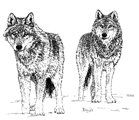Wildlife Damage Management, Internet Center for
Date of this Version
November 2006
Abstract
1) Why was the gray wolf listed as endangered?
2) What types of habitat do wolves use?
3) Do wolves need wilderness areas to survive? Can they survive near urban areas?
4) How far do wolves travel?
5) What do wolves eat?
6) If wolf numbers get too high will deer and elk be eliminated?
7) How do wolves in an area affect deer hunting?
8) Do wolves really take the old, young, sick, starving, or injured animals?
9) Do wolves kill more than they can eat?
10) Does the presence of wolves affect the numbers of animals other than their prey?
11) What is a wolf pack?
12) How many wolves are in a pack?
13) Do wolves mate for life?
14) What happens to a pack when the alpha male or female is killed?
15) How does a non-breeding wolf attain breeding status?
16) When do wolves mate?
17) Where do wolves give birth to their young?
18) At what age are wolf pups weaned?
19) How long do wolf pups stay in the den?
20) How long do wolves live?
21) In protected populations, what kills wolves?
22) Are wolves a threat to humans, in particular small children?
23) Is there any danger from wolves to my pets?
25) How big are wolves?
26) How can you tell the difference between a gray wolf and a coyote or a large dog?
27) How can I learn more about wolves and the things that are going on right now that will affect their future?



Comments
Published by U.S. Fish and Wildlife Service. November 2006.